Choosing the best GPS watch for long-distance hiking hinges on features like robust navigation tools, extended battery life, and durable construction. Significant models include the Garmin Enduro 2 with its astounding 150-hour GPS mode battery life, and the Garmin Instinct 2 Solar offering unlimited battery in smartwatch mode through solar charging. Durable design is vital, exemplified by watches like the Casio Pro Trek PRW3500-1, featuring 200m water resistance. Budget-friendly options such as the Garmin Forerunner 55 deliver functionality without a hefty price tag. Understanding these features can aid in deciding which watch best suits your hiking needs.
Key Takeaways
- Garmin Enduro 2 offers exceptional battery life with up to 150 hours in GPS mode, ideal for extended hikes.
- Garmin Instinct 2 Solar provides unlimited battery life with solar charging, ensuring reliability in remote areas.
- Garmin fenix 7X Sapphire Solar combines advanced features with 37-day battery life, suitable for tech-savvy hikers.
- Suunto Core is a budget-friendly option with essential functionalities, though it lacks GPS features.
- Casio Pro Trek PRW3500-1 is highly durable with 200m water resistance, perfect for extreme hiking conditions.
Essential Features of GPS Watches
When selecting a GPS watch for hiking, it is imperative to contemplate the essential features that frequently determine its efficacy and reliability in the field. Advanced navigation tools are paramount, enabling hikers to accurately track routes and monitor important statistics such as distance and elevation. This precision is achieved through satellite triangulation, ensuring that users can confidently navigate even the most challenging terrains while prioritizing hiking safety.
Extended battery life is another significant consideration, especially for multi-day hikes. Some models offer up to 150 hours of GPS tracking, which is essential for prolonged excursions. The inclusion of solar charging capabilities further enhances the watch's utility, allowing it to harness solar energy to extend its operational time in remote areas devoid of power sources.
Moreover, many GPS watches integrate altimeters and barometers, which provide enhanced location accuracy and assist in weather prediction—both critical for effective outdoor navigation.
The watch's design must be both durable and lightweight, typically ranging from 41g to 89g, crafted from materials that can endure harsh outdoor conditions without compromising comfort.
Top Picks for 2024
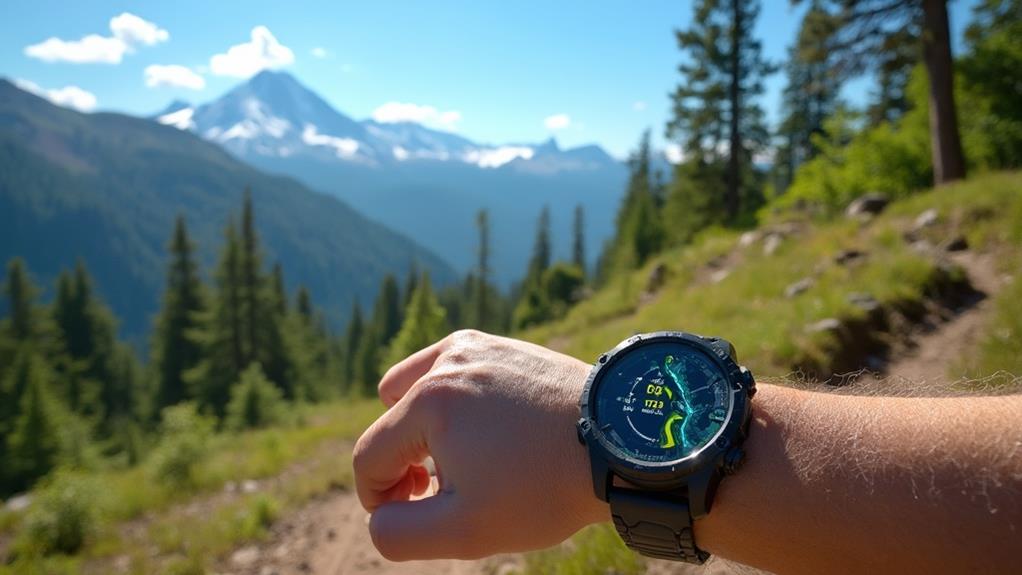
Showcasing a blend of innovation and functionality, the top GPS watches for 2024 cater to both seasoned hikers and outdoor enthusiasts looking for reliable navigation tools. The Garmin Instinct 2 Solar stands out with its remarkable battery life—up to 28 days in smartwatch mode and unlimited with solar charging—making it a favorite in user reviews for its endurance on long hikes. In feature comparisons, the Garmin fenix 7X Sapphire Solar offers advanced capabilities, including a 37-day battery life in smartwatch mode, though at a high price point of $1,000. For those seeking extreme endurance, the Garmin Enduro 2 impresses with 150 hours of GPS mode when solar-powered, matching its sibling's price.
For hikers on a budget, the Suunto Core provides essential ABC functionalities at $200+, though it lacks GPS. The Apple Watch Ultra 2 merges smart features and GPS at $799, appealing to tech-savvy adventurers.
| Watch Model | Notable Feature |
|---|---|
| Garmin Instinct 2 Solar | Unlimited solar battery |
| Garmin fenix 7X Sapphire | Advanced features, 37-day battery |
| Suunto Core | Budget-friendly, essential functions |
These choices reflect a range of needs and budgets, ensuring every hiker finds the ideal companion.
Durability and Build Quality
In the domain of GPS watches designed for hiking, durability and build quality are paramount, ensuring reliability in unpredictable environments. High-end models like the Garmin fenix 7X Pro and Suunto Vertical Titanium Solar exemplify superior material selection, employing sapphire glass for scratch resistance and stainless steel or titanium for structural integrity.
These materials not only enhance impact resistance but also contribute to design aesthetics, appealing to both functionality and style versatility. Water resistance is another important aspect, with most models boasting ratings of 100m or higher, providing assurance against water ingress during river crossings or unexpected downpours.
The Garmin Enduro 2, with its lightweight yet sturdy 70g build, demonstrates effective user customization, offering a comfortable fit for prolonged wear with various sizing options. Additionally, features like reinforced cases and adherence to military-grade construction standards (MIL-STD-810) are essential for enduring impacts, extreme temperatures, and humidity.
For maintenance, regularly clean the watch with a soft cloth and avoid exposure to harsh chemicals to preserve its longevity. Regarding style versatility, these watches can seamlessly shift from rugged outdoor settings to casual or professional environments, making them a valuable investment for any hiker.
Battery Life Comparison
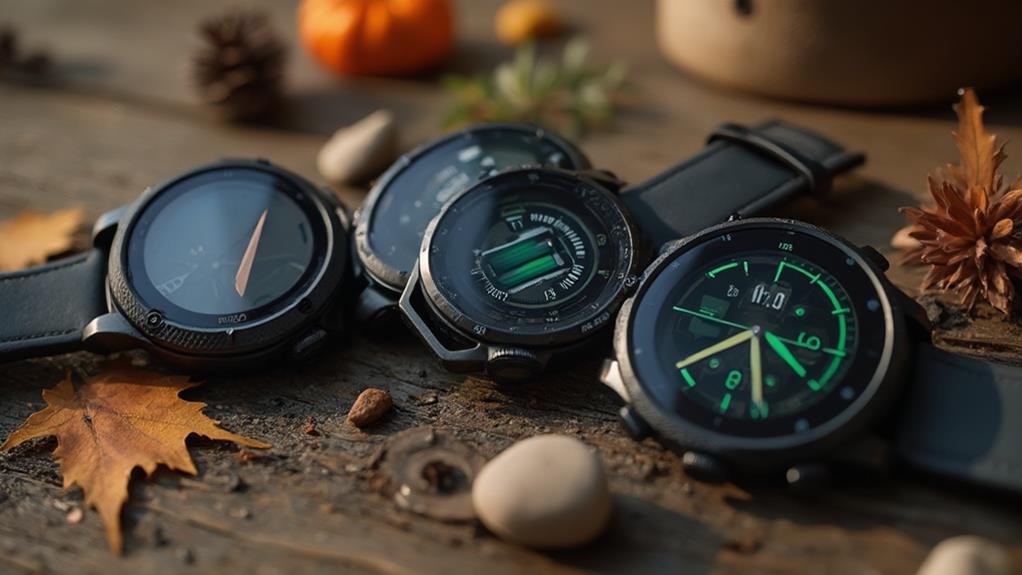
Amid the diverse landscape of GPS watches tailored for hiking, battery life stands as a vital factor differentiating models for long-distance trekkers.
Understanding battery longevity and solar efficiency is essential for selecting a watch that can endure the rigors of extended hiking trips.
Here's a detailed comparison of the best options available:
- Garmin Instinct 2 Solar: With a potential for unlimited battery life thanks to its solar charging capability, and up to 28 days in smartwatch mode, this model is ideal for those prioritizing solar efficiency.
- Garmin fenix 7X Pro Sapphire Solar: Offers a robust battery life of up to 37 days in smartwatch mode and 122 hours in GPS mode. Its solar efficiency guarantees reliable performance over extended periods.
- Garmin Enduro 2: Designed for extreme endurance, this watch provides up to 150 hours in GPS mode with solar charging, making it perfect for ultra-long treks.
- Suunto Vertical Titanium Solar: Boasting 30 days in smartwatch mode and over 60 hours with GPS, it is a reliable choice for multi-day hikes, balancing battery longevity with solar capabilities.
Choosing a GPS watch with impressive battery life and efficient solar charging can greatly enhance the hiking experience, assuring your device remains operational throughout your adventure.
GPS Accuracy and Performance
When evaluating GPS watches for hiking, GPS accuracy and performance are vital considerations for ensuring reliable navigation during excursions. Multi-band GPS technology, as seen in models like the Garmin Fenix 7 Pro and Forerunner 965, greatly enhances precision, maintaining distance accuracy within 1-3% even in challenging terrains such as canyons. This is achieved through superior satellite coverage and the use of at least four satellites, which are fundamental for accurate position triangulation without relying on cellular service.
GPS signal interference is a common challenge faced during long-distance hikes, particularly in areas with poor satellite visibility. Dual-frequency GPS models address this issue by providing more reliable location tracking, ensuring hikers can navigate confidently. The advanced GPS chipsets in these watches further bolster their performance metrics, making them top contenders in accuracy ratings.
While the integration of heart rate monitors enhances functionality, their precision often falls short compared to traditional chest straps. Nonetheless, the Garmin Forerunner 965 and Fenix 7 Pro Solar excel in performance, offering extensive tracking capabilities.
For any hiker, prioritizing a watch with robust GPS technology and minimal signal interference is essential for successful navigation in diverse environments.
Comfort and Wearability
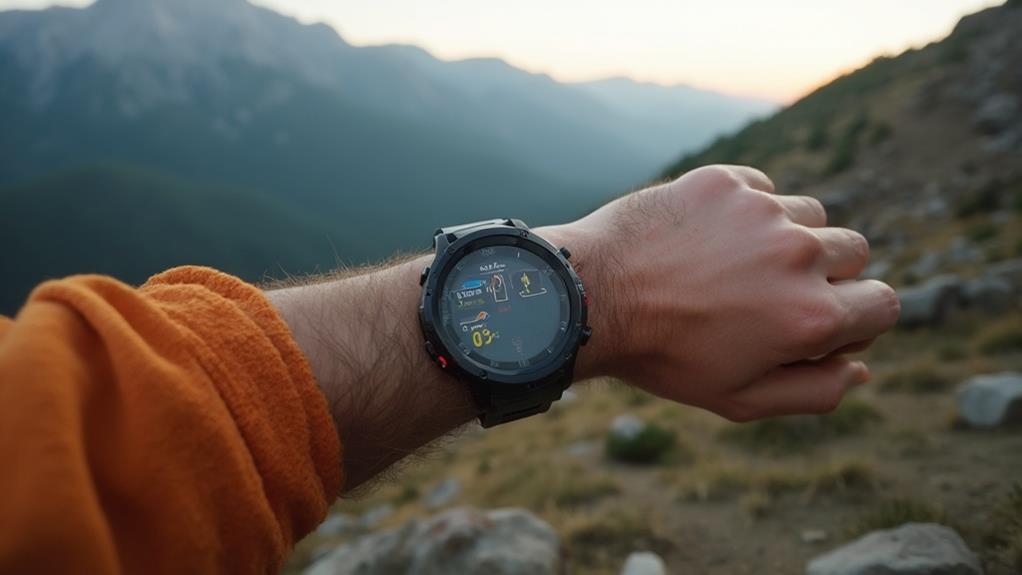
Selecting a GPS watch for hiking extends beyond just technical capabilities; comfort and wearability are equally essential factors. For long-distance hikes, the watch must be lightweight to minimize fatigue, exemplified by models like the Garmin Instinct 2 Solar at just 53g.
Equally important are the strap materials and case designs, which greatly impact comfort over prolonged usage. Silicone or breathable strap materials are particularly effective, reducing the risk of chafing and enhancing overall wearability.
Smaller case designs cater to individuals with petite wrists, guaranteeing a snug yet comfortable fit. This is vital, as ill-fitting watches can cause discomfort and distractions during an activity demanding focus.
Beyond aesthetics, durable materials such as sapphire glass and stainless steel enhance comfort by mitigating wear-related issues. These materials offer resilience and longevity, making sure the watch remains a reliable companion throughout various terrains.
Consider the following when selecting a GPS watch for hiking:
- Weight: Opt for lightweight models to reduce fatigue.
- Strap Materials: Choose silicone or breathable materials.
- Case Size: Select sizes appropriate for wrist dimensions.
- Durability: Prioritize rugged materials for lasting comfort.
These considerations guarantee the watch not only performs well but also remains a comfortable companion on the trail.
Best for Extreme Conditions
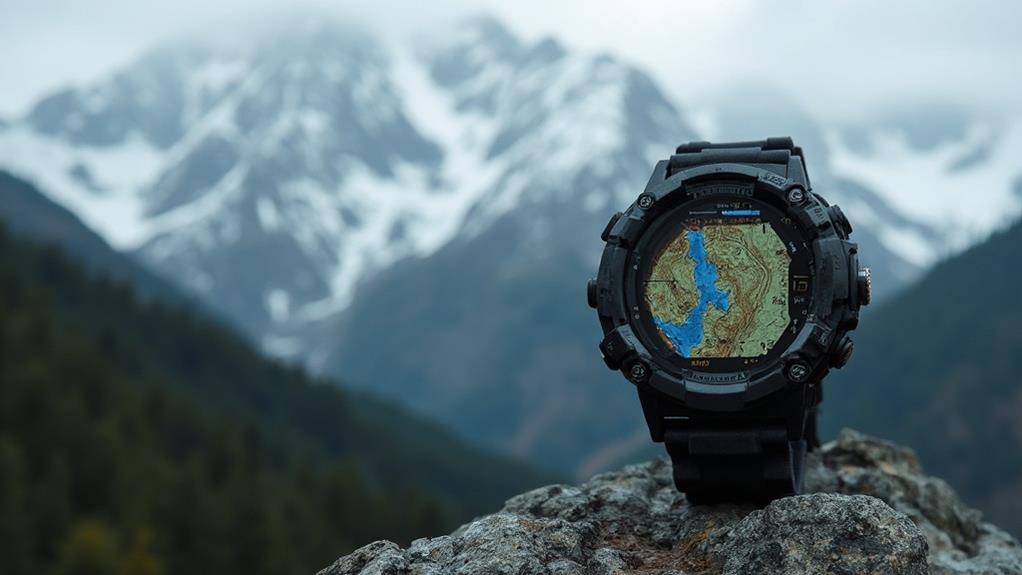
When venturing into extreme environments, choosing a GPS watch that excels in both durability and battery longevity is paramount.
Devices like the Garmin Enduro 2 and Coros Vertix 2 offer exceptional battery performance, ensuring functionality over extended periods, while models such as the Casio Pro Trek PRW3500-1 provide formidable resilience against harsh weather conditions.
For hikers tackling tough terrains, these watches deliver essential support through advanced features and robust designs, making them indispensable tools for traversing challenging landscapes.
Durability in Harsh Environments
In the domain of extreme outdoor activities, a few GPS watches stand out for their exceptional durability in harsh environments.
These devices are meticulously crafted, incorporating advanced material selection and rugged features to withstand the most demanding conditions. The Garmin Enduro 2 is renowned for its robust construction, enabling it to endure the rigors of extreme endurance activities. Its design aesthetics fuse functionality with style, appealing to both seasoned adventurers and design-conscious users.
The Suunto Vertical Titanium Solar is another exemplary model, utilizing titanium for superior impact resistance and temperature tolerance. This watch has garnered positive user testimonials highlighting its resilience in challenging terrains.
Similarly, the Garmin Fenix 7X Pro Sapphire Solar features a scratch-resistant Power Glass display, which enhances its durability against external elements.
The Casio Pro Trek PRW3500-1 exemplifies rugged features with its 200m water resistance, making it ideal for aquatic adventures and harsh climatic conditions.
Finally, the Garmin Instinct 2 Solar, with its lightweight design, meets military-grade standards for thermal, shock, and water resistance.
- Material Selection: Titanium, Sapphire Glass
- Impact Resistance: Military-grade standards
- Temperature Tolerance: High resilience
- User Testimonials: Positive reviews for durability
These watches are indispensable tools for those seeking reliability in unforgiving environments.
Extended Battery Performance
For hikers venturing into extreme conditions, a GPS watch with extended battery performance is an essential tool. The Garmin Enduro 2 leads the pack with an extraordinary battery life of up to 150 hours in GPS mode and 34 days in smartwatch mode, offering unmatched reliability for long-distance hiking.
To optimize battery life, users should minimize GPS usage when not needed and adjust settings like screen brightness. Additionally, the Garmin Fenix 7X Pro Sapphire Solar utilizes solar charging benefits, extending its GPS usage to 122 hours and providing up to 37 days in smartwatch mode. This feature is particularly beneficial for hikers in sun-rich environments, allowing on-the-go charging without access to power outlets.
The Suunto Vertical Titanium Solar, designed for rugged terrains, provides over 60 hours of GPS tracking. It emphasizes battery longevity tips, such as using power-saving modes, to extend its 30-day smartwatch capability.
For virtually unlimited power, the Garmin Instinct 2 Solar offers unlimited battery life in smartwatch mode with solar charging, ensuring continuous performance in outdoor expeditions.
Budget-Friendly Options

Exploring the domain of budget-friendly GPS watches often reveals a range of practical and efficient options that cater to the needs of hikers without breaking the bank. Affordable alternatives abound, providing reliable performance while accommodating budget constraints.
The Garmin Forerunner 55, priced at approximately $199, is a lightweight choice offering essential tracking features with a commendable battery life of up to two weeks in smartwatch mode. Its affordability makes it a favored option among budget-conscious hikers.
The Fitbit Charge 6, available around $148, delivers basic health tracking capabilities with a comfortable design, sustaining a battery life of up to seven days. It's ideal for casual outdoor enthusiasts seeking practicality without excess expenditure.
For those needing more durability and extended usage, the Garmin Instinct 2S at $249.99 provides rugged construction and basic GPS functionalities, lasting up to 28 days in smartwatch mode.
- Garmin Forerunner 55: Lightweight, $199, 2-week battery
- Fitbit Charge 6: Health tracking, $148, 7-day battery
- Garmin Instinct 2S: Rugged, $249.99, 28-day battery
- Coros Pace 3: Reliable tracking, $229, 17-day battery
Ultimately, these selections represent versatile, budget-friendly options for hikers prioritizing value and functionality.
Connectivity and Smart Features
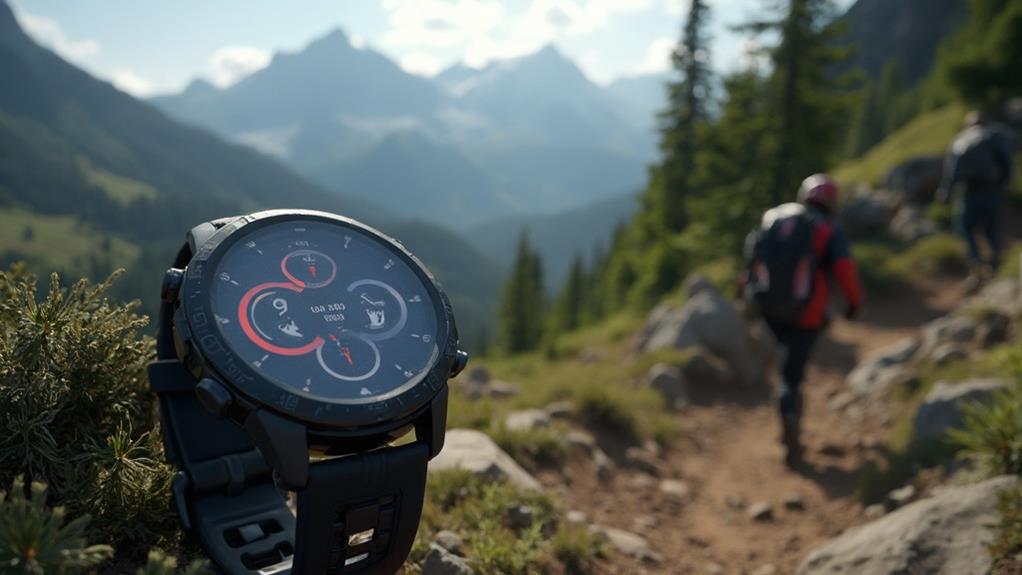
In the domain of GPS watches for hiking, enhanced connectivity options and smart features noticeably enhance the user experience.
Models like the Garmin Instinct 2 Solar and Apple Watch Ultra 2 provide seamless smartphone integration, allowing for real-time notifications and communication directly from the wrist.
Additionally, compatibility with popular fitness apps and advanced navigation capabilities, such as those offered by the Garmin fenix 7X Pro, streamline performance tracking and route planning, ensuring hikers are well-equipped for both immediate and strategic decision-making on the trail.
Enhanced Connectivity Options
Modern GPS watches frequently incorporate enhanced connectivity options, offering an array of smart features designed to elevate the hiking experience. Real-time updates and offline maps are essential for long-distance hikers who often traverse areas with limited connectivity.
Watches like the Garmin Instinct 2 Solar and Apple Watch Ultra 2 utilize Bluetooth and Wi-Fi connectivity, allowing users to sync data with smartphones, guaranteeing that vital notifications and updates are always accessible, even on the trail.
Several models, including the Suunto Vertical Titanium Solar, offer GPX file syncing, which allows hikers to import custom routes for off-trail navigation. This feature is invaluable for adventurers who plan to explore less-traveled paths.
Moreover, advanced connectivity capabilities in devices like the Garmin fenix 7 Pro Series facilitate integration with third-party apps such as Strava for performance tracking and music streaming services.
Key connectivity features include:
- Bluetooth and Wi-Fi connectivity: Sync data and receive notifications.
- GPX file support: Import and navigate custom routes.
- Third-party app compatibility: Track performance and enjoy music.
- Built-in satellite navigation tools: provide accurate positioning without cellular service.
These features collectively guarantee that hikers remain informed, safe, and entertained throughout their journey.
Smart Features Integration
Smart features integration in GPS watches has greatly enhanced the hiking experience by merging connectivity with practical functionalities. Modern devices like the Garmin Fenix 7 Pro and Apple Watch Ultra 2 utilize Bluetooth and Wi-Fi to sync with smartphones, facilitating seamless fitness app integration. This connectivity allows hikers to track their progress with apps such as Strava and Apple Health, providing detailed fitness metrics and fostering an engaged hiking routine.
Additionally, notification management is streamlined, as many models provide alerts for calls, texts, and app notifications directly on the wrist. This reduces distractions by eliminating the need to frequently check smartphones during hikes. The technology integration in these watches extends to contactless payments, with features like Garmin Pay simplifying transactions on the trail.
| Feature | Example Models |
|---|---|
| Bluetooth & Wi-Fi | Garmin Fenix 7 Pro |
| Fitness App Integration | Apple Watch Ultra 2 |
| Notification Management | Garmin Instinct 2 Solar |
| Contactless Payments | Supported in several models |
Moreover, the incorporation of weather forecasting and navigation apps is crucial. These features provide real-time environmental updates and route planning, enhancing safety and ensuring hikers are well-prepared for any conditions. The synthesis of these technologies makes GPS watches indispensable for the modern long-distance hiker.
Advanced Tracking Capabilities
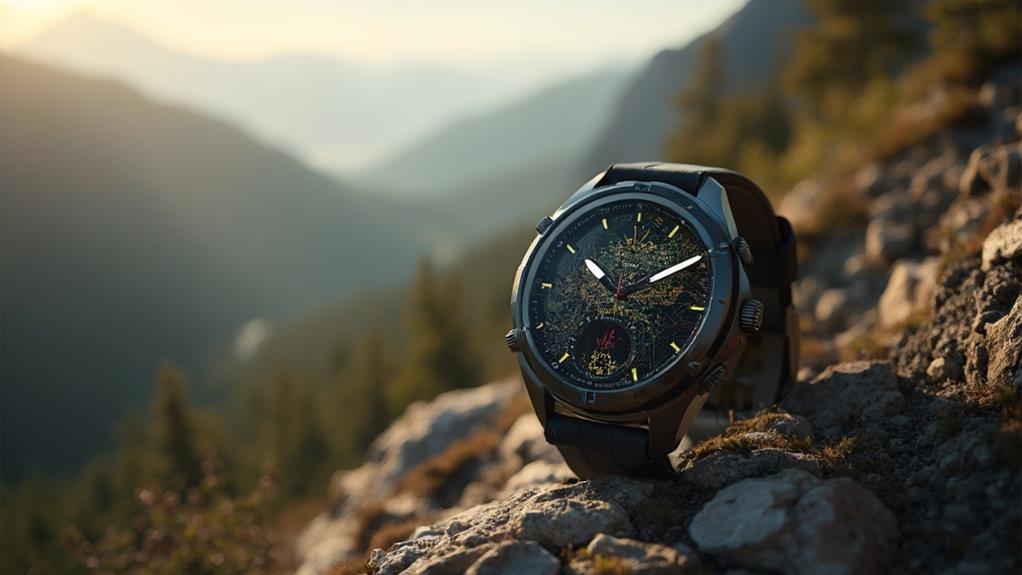
Advanced tracking capabilities in GPS watches have revolutionized the way hikers navigate challenging terrains. Leveraging real-time tracking and elevation monitoring, modern GPS watches like the Garmin Fenix 7 Pro deliver thorough navigation solutions.
By employing multi-band GPS technology, these devices can triangulate signals from various satellite systems, ensuring improved location accuracy crucial for long-distance hiking. Such precision allows hikers to confidently tackle unfamiliar landscapes, making these watches indispensable for serious adventurers.
Key features of advanced GPS watches include:
- Real-time tracking: Provides continuous updates on location, enabling hikers to react quickly to changes in terrain or direction.
- Elevation monitoring: Utilizes pressure-based altimeters to track elevation gain and loss, supplying essential data for managing climbs and descents.
- Breadcrumb tracking: Facilitates the retracing of steps in unfamiliar areas, enhancing safety and navigation efficiency.
- Extensive mapping capabilities: Allows for preloading of topographic maps and direct route planning on the watch.
Additionally, watches with robust battery management systems cater to multi-day expeditions, offering power-saving modes that extend GPS tracking up to 150 hours.
For hikers seeking dependability and performance, these advanced tracking capabilities provide the necessary tools to navigate and conquer challenging hiking adventures.
User Experience and Interface
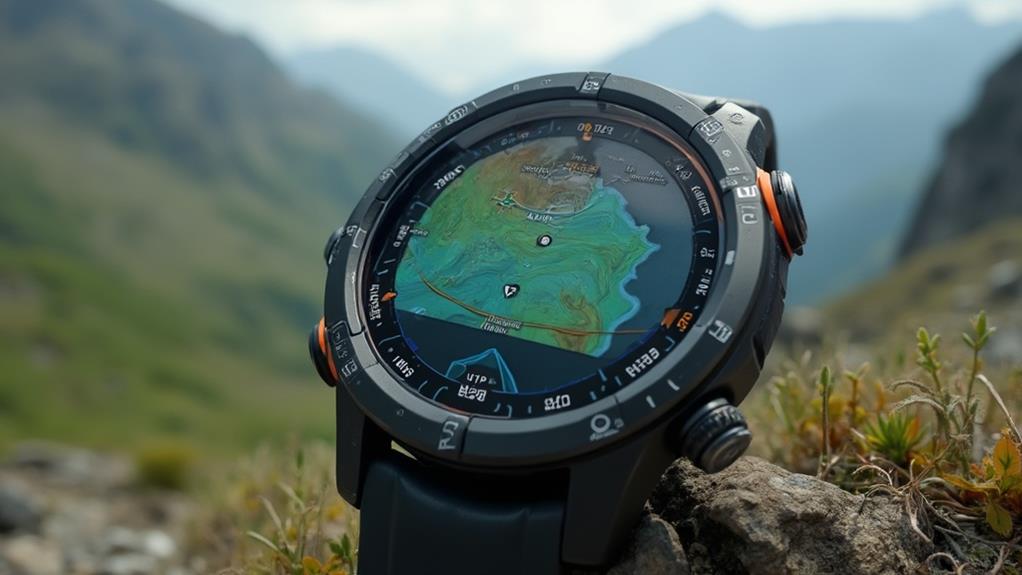
User experience in GPS watches for hiking is heavily influenced by the intuitiveness of navigation controls, which can greatly enhance the user's ability to access essential information quickly.
Screen visibility, particularly in outdoor environments, is a critical factor; while AMOLED displays offer striking visuals, transflective displays often provide better readability in direct sunlight and extended battery life.
The decision between button and touchscreen interfaces should be guided by the hiking conditions, with tactile buttons generally offering greater reliability in harsh or wet environments where touchscreens might falter.
Intuitive Navigation Controls
How do intuitive navigation controls enhance the hiking experience with GPS watches? Intuitive navigation controls are pivotal in maximizing the functionality of GPS watches, particularly for long-distance hiking. By employing user-friendly interfaces, these devices streamline access to essential features like route planning and tracking, making them indispensable on challenging treks.
For instance, the Garmin Instinct 2 Solar's button navigation is optimized for rugged environments, enabling hikers to operate the watch efficiently, even with gloves on. This guarantees consistent performance regardless of external conditions.
Exploring the variety of navigation controls available, several key features stand out:
- Touchscreen functionality: Models like the Garmin Fenix 7 Pro offer responsive touchscreen interfaces, facilitating easy map zooming and setting adjustments on-the-go.
- App integration: The Garmin Connect app enhances the user experience by allowing seamless route management and data review from a smartphone.
- Customizable menus: Premium watches provide options to tailor navigation settings, enabling hikers to prioritize frequently used features, thereby improving operational efficiency.
- Reliability in harsh conditions: Physical buttons guarantee functionality in severe weather, an advantage over touchscreen-only models.
Screen Visibility Outdoors
Guaranteeing ideal screen visibility outdoors is essential for GPS watches, especially when hiking in diverse lighting conditions. The choice of display technology greatly influences this aspect. Transflective displays, often found in models like the Garmin Instinct 2 Solar, are particularly advantageous due to their ability to leverage ambient light. This feature minimizes screen glare and maintains readability under direct sunlight without compromising battery efficiency, a critical factor for long-distance hikers with limited access to charging facilities.
In contrast, AMOLED displays offer superior color vibrancy and sharpness but at the cost of increased power consumption, which can be a significant drawback on extended hikes. Consequently, while AMOLED screens are visually appealing, their practicality is limited in scenarios where battery longevity is paramount.
Anti-glare coatings, such as those implemented on the Garmin Fenix 7 Pro, further enhance screen visibility by reducing surface reflections, thereby aiding navigation on unfamiliar trails.
Additionally, user feedback underscores the importance of screen size and clarity, noting that larger displays improve usability by allowing hikers to quickly access navigation and performance data.
Ultimately, selecting the right display technology guarantees a seamless user experience in challenging outdoor environments.
Button vs. Touch Interface
When it comes to the overall user experience of GPS watches, the interface plays a vital role alongside screen visibility. The choice between button and touch interfaces can greatly impact functionality, particularly in challenging conditions.
Button interfaces offer notable advantages such as tactile feedback, which is fundamental for reliable navigation in rugged environments. They are especially beneficial when dealing with touchscreen drawbacks like reduced responsiveness in wet conditions or when wearing gloves. This provides a practical edge during long-distance hikes where quick, reliable adjustments are essential.
Touchscreen displays, while offering intuitive and swift access to features, come with their own set of challenges. They tend to drain battery life more quickly, particularly in always-on settings, which is a significant consideration for extended outdoor activities.
Despite their appeal for casual navigation, the feedback from outdoor enthusiasts often leans toward button interfaces for their simplicity and dependability under physical stress.
- Tactile feedback: Guarantees reliable use in challenging environments.
- Battery efficiency: Button-operated models are often more power-conservative.
- Simplicity and reliability: Favored for essential functions during strenuous activities.
- Flexible models: Some, like the Garmin Fenix series, offer both interfaces for versatility.
Value for Money
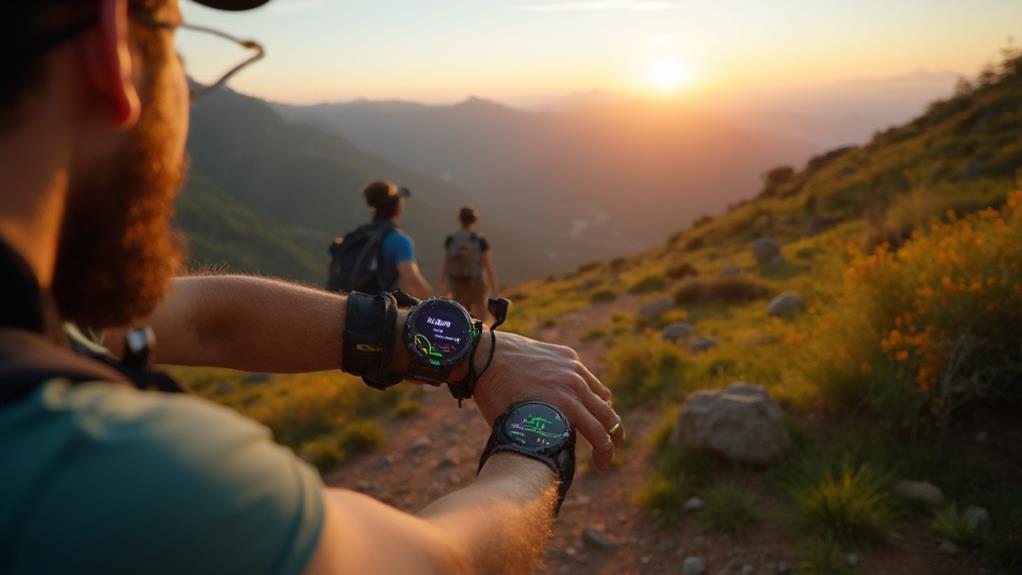
In the domain of hiking GPS watches, selecting a model that offers true value for money requires a nuanced understanding of features versus price. Conducting value comparisons and price analysis highlights several options for long-distance hikers.
The Garmin Instinct 2 Solar, priced at $349.99, stands out with its remarkable 28-day battery life in smartwatch mode, ideal for extended hikes with minimal recharging needs. This model serves as a benchmark for value, balancing advanced features and durability.
For budget-conscious hikers, the Suunto Core at approximately $200 provides essential altimeter, barometer, and compass (ABC) functions without GPS. This makes it a practical, economical choice for navigation-focused hiking without the cost of advanced functionalities.
Meanwhile, the Coros APEX 2 offers a compelling blend of performance and affordability, boasting over 45 hours of battery life in GPS mode. This guarantees reliability for extended treks without breaking the bank.
For those seeking mid-range options, the Polar Pacer Pro, retailing at $289, delivers 25 hours of GPS tracking, catering to fitness enthusiasts who prioritize endurance and basic functionality.
Conversely, the Garmin Fenix 7 Pro Solar, though priced at $800, provides unparalleled mapping capabilities and durability for serious hikers, justifying its higher cost through long-term utility.
Frequently Asked Questions
Which Garmin Watch Is Best for Altitude?
For maximum altitude accuracy, consider the Garmin fenix 7X Pro Solar, featuring advanced Garmin features like mapping capabilities and a robust altimeter. Its multi-band GPS guarantees precise altitude readings, making it ideal for challenging, mountainous environments.
What Is the Best Garmin for Trail Navigation?
The Garmin fenix 7 Pro Series, with advanced trail mapping capabilities and robust Garmin features including multi-band GPS, is highly recommended for superior trail navigation, combining detailed analysis of terrain with practical route planning for outdoor enthusiasts.
Do You Need a GPS Watch for Hiking?
While not essential, a GPS watch enhances hiking safety by providing precise navigation tips and route tracking. It supplements traditional tools, ensuring reliable performance in unfamiliar terrains, thereby offering practical advantages for those seeking detailed navigational assistance.
What Is the Best Watch for Tracking Distance?
The Garmin Fenix 7 Pro Solar excels in distance accuracy and battery life, offering superior GPS tracking for extended durations. Its advanced mapping capabilities and robust design make it highly suitable for users prioritizing precision and endurance in challenging conditions.
Conclusion
When selecting a GPS watch for long-distance hiking, prioritizing essential features such as durability, battery life, and GPS accuracy is vital. The top picks for 2024 offer robust construction, extended battery performance, and precise navigation capabilities. Connectivity and smart features enhance user experience, while advanced tracking capabilities provide valuable data for serious hikers. Analyzing user interface ease and value for money guarantees an informed decision, optimizing both performance and cost-effectiveness in challenging outdoor environments.